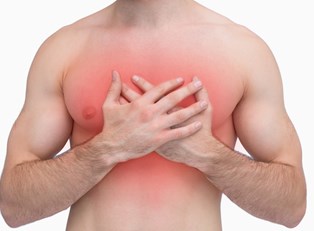A wide range of health problems can cause chest pain, all of which deserve medical attention. Several issues relating to the heart can cause chest pain, but many other causes are related to the digestive system, musculoskeletal system, and respiratory system. Chest pain is one of the most common reasons people call for emergency medical help. Every year, ER (emergency room) doctors evaluate and treat millions of people for chest pain. Fortunately, chest pain doesn't always signal a heart attack. Most often, chest pain is unrelated to the heart. But even if the chest pain has nothing to do with the cardiovascular system, what is causing it may still be important and worth the time seeking medical help for evaluation. Common chest pain causes include angina, aortic dissections, coronary spasm (Prinzmetal's angina), pericadities (heart inflammation), and other causes related to the digestive system, musculoskeletal system, and respiratory system. Heartburn, esophageal spasm, hiatal hernia, achalasia (swallowing disorder), and gallbladder or pancreas problems can cause chest and abdominal pain. Other chest pain causes include pleurisy, panic attack, shingles (rash infection) and rarely cancer. There is no easy way to identify a chest pain cause without seeing a physician.
Treating Chest Pain Medically
When seeking medical evaluation for chest pain, the typical approach involves ruling out the most dangerous causes: heart attack, pulmonary embolism, thoracic aortic dissection, esophageal rupture, tension pneumothorax and cardiac tamponade. By elimination or confirmation of the most serious causes, a diagnosis of the cause may be made, and often no definite cause will be found. A rapid diagnosis can save lives and often must be made without the help of X-rays or labs (blood tests); however, labs will test the complete blood count, electrolytes and renal function, liver enzymes, creatine kinase, troponin, D-dimer, and serum amylase, all of which help eliminate or confirm some of the many chest pain causes. A focus on recent health changes, family history, tobacco smoking, diabetes and other risk factors is useful. Once the chest pain cause is identified, any number of wide-ranging treatments may be prescribed, usually involving narcotic pain medications (Codeine, Darvocet, Dereol, Oxycodone, OxyContin, Percocet, Vicodin), nonsteroidal anti-inflammatory medications (Advil, Alleve, Aspirin, Ibuprofen, Motrin, Naproxen) and antibiotics. If seeking medical help, one should have someone drive him or her to the hospital and should not waste any time out of fear of embarrassment if it's not a heart attack.
Chest Pain Lifestyle and Home Treatment
Chest pain home treatment is not appropriate if the pain occurs with heart attack symptoms. Most people who have been diagnosed with angina have a pattern to their attacks that they recognize. Those individuals should follow the treatment plan outlined with their doctor. Home treatment for minor chest pain depends on the cause. For pains caused by strained muscles or ligaments, or a fractured rib, one might rest and protect the sore area, ice the area for ten to twenty minutes to reduce pain and swelling, rub a medicated cream designed to relieve sore muscles, gently massage the sore area, and then slowly return to normal activity as the pain subsides. Over-the-counter pain relievers may help. Examples include acetaminophen (Tylenol), ibuprofen (Advil), Naproxen (Aleve) and aspirin (Bayer). Understanding family medical history, including other health problems close relatives have or have had will help one understand how to reduce the risk of chest pain as well as help a doctor's diagnosis. Habits and changes in lifestyle that may reduce chest pain include avoiding strenuous activities, eating balanced and nutritious meals low in fats, maintaining a healthy weight, limiting alcohol consumption, quitting smoking, reducing stress, controlling blood pressure, avoiding extreme temperatures, and following an appropriate exercise program.



